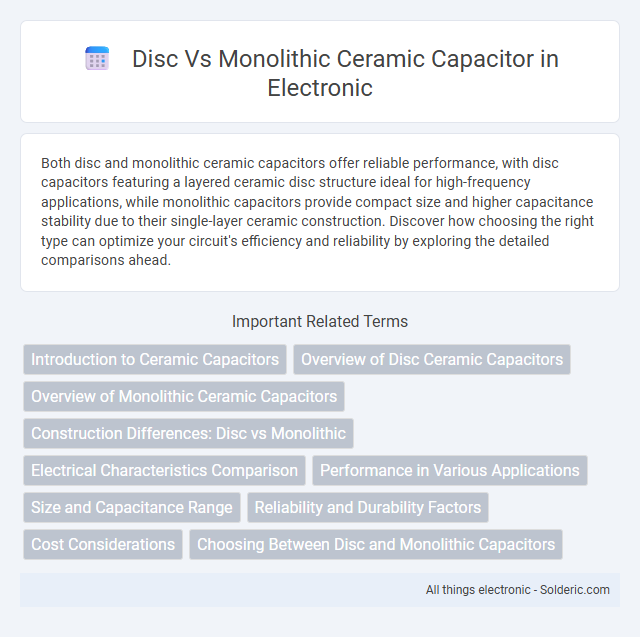Both disc and monolithic ceramic capacitors offer reliable performance, with disc capacitors featuring a layered ceramic disc structure ideal for high-frequency applications, while monolithic capacitors provide compact size and higher capacitance stability due to their single-layer ceramic construction. Discover how choosing the right type can optimize your circuit's efficiency and reliability by exploring the detailed comparisons ahead.
Comparison Table
| Feature | Disc Ceramic Capacitor | Monolithic Ceramic Capacitor |
|---|---|---|
| Construction | Single ceramic disc with metal electrodes | Multiple ceramic layers stacked with internal electrodes |
| Size | Larger physical size | Compact, smaller footprint |
| Capacitance Range | Low to moderate (pF to nF) | Wide range (pF to uF) |
| Voltage Rating | Typically higher voltage ratings (up to kV) | Moderate voltage ratings (tens to hundreds of volts) |
| Performance | Stable for high-voltage, lower frequency | Better high-frequency performance, low ESR |
| Applications | Power electronics, high voltage filtering | Surface-mount circuits, RF, decoupling, general electronics |
| Mounting Style | Through-hole | Surface-mount technology (SMT) |
| Cost | Generally lower cost for high voltage | Cost-effective for mass SMT production |
Introduction to Ceramic Capacitors
Ceramic capacitors are essential passive components used in electronic circuits to store and release electrical energy rapidly, with disc and monolithic types being the most common. Disc ceramic capacitors consist of ceramic dielectric materials shaped into discs, offering high capacitance values and durability, making them suitable for high-frequency applications. Monolithic ceramic capacitors, fabricated using multilayer ceramic technology, provide compact size, stable performance, and low equivalent series resistance (ESR), ideal for surface-mount devices in modern electronics.
Overview of Disc Ceramic Capacitors
Disc ceramic capacitors feature a compact, disc-shaped ceramic dielectric that offers high stability and low loss in electronic circuits. Their construction allows for efficient handling of high-frequency signals and voltage ratings suitable for filtering, bypassing, and coupling applications. You can rely on disc ceramic capacitors for consistent performance in environments demanding reliable capacitance and thermal stability.
Overview of Monolithic Ceramic Capacitors
Monolithic ceramic capacitors consist of multiple layers of ceramic dielectric and metal electrodes, creating a compact, high-capacitance component ideal for surface-mount technology (SMT) applications. Compared to disc ceramic capacitors, monolithic versions offer superior reliability, tighter tolerance, and better performance at high frequencies due to their multilayer construction. Your electronic designs benefit from enhanced stability and miniaturization by using monolithic ceramic capacitors over their disc counterparts.
Construction Differences: Disc vs Monolithic
Disc capacitors feature a layered ceramic dielectric with metal electrodes stacked and formed into a disc shape, enabling high voltage handling and mechanical robustness. Monolithic ceramic capacitors are constructed by co-firing multiple thin ceramic and electrode layers into a single, compact block, ensuring higher capacitance density and superior electrical performance. Your choice depends on the required capacitance, size constraints, and application-specific reliability demands.
Electrical Characteristics Comparison
Disc capacitors typically offer lower capacitance values and higher equivalent series resistance (ESR) compared to monolithic ceramic capacitors, which feature higher capacitance density and lower ESR for improved performance in high-frequency applications. Monolithic ceramic capacitors provide superior stability, lower dielectric absorption, and better temperature coefficient characteristics, making them ideal for precision circuits. You can achieve enhanced filtering and decoupling efficiency by choosing monolithic ceramic capacitors where low loss and high reliability are critical.
Performance in Various Applications
Disc ceramic capacitors excel in high-frequency applications due to their low equivalent series resistance (ESR) and inductance, making them suitable for RF circuits and signal filtering. Monolithic ceramic capacitors offer superior stability and reliability in temperature-sensitive and precision applications, such as aerospace and medical devices, thanks to their uniform dielectric material and compact structure. Each type's performance varies depending on the electrical environment, with disc capacitors favored for transient handling and monolithic types preferred for consistent capacitance under stress.
Size and Capacitance Range
Disc ceramic capacitors typically offer smaller physical sizes and are available in capacitance ranges from a few picofarads up to several microfarads, making them suitable for compact circuit designs. Monolithic ceramic capacitors, also known as multilayer ceramic capacitors (MLCCs), provide a broader capacitance range reaching into the tens of microfarads while maintaining extremely small footprints due to their multilayer construction. The compact size and wide capacitance range of MLCCs make them ideal for high-density electronic assemblies requiring stable, high-capacitance solutions.
Reliability and Durability Factors
Disc ceramic capacitors offer high reliability in general-purpose applications due to their robust construction, but their durability may be limited under mechanical stress and high-temperature variations. Monolithic ceramic capacitors provide superior reliability and extended durability, as their layered structure ensures better performance under thermal cycling and vibration conditions. Choosing the right capacitor affects your circuit's longevity, making monolithic types preferable for demanding environments requiring stable capacitance and low failure rates.
Cost Considerations
Disc ceramic capacitors generally offer lower cost advantages due to simpler manufacturing processes and widespread use in low-frequency applications, making them ideal for budget-sensitive projects. Monolithic ceramic capacitors, while typically more expensive, provide higher capacitance stability and reliability in high-frequency circuits, justifying their cost in precision designs. The price difference reflects trade-offs between performance characteristics and production scale efficiencies in industrial and consumer electronics.
Choosing Between Disc and Monolithic Capacitors
Choosing between disc and monolithic ceramic capacitors depends on application requirements such as capacitance value, size constraints, and electrical performance. Disc ceramic capacitors offer higher capacitance and better stability at high voltages, making them suitable for power and filtering applications. Monolithic ceramic capacitors provide compact size, low equivalent series resistance (ESR), and superior frequency characteristics, ideal for high-frequency and surface-mount device (SMD) circuits.
disc vs monolithic ceramic capacitor Infographic

 solderic.com
solderic.com